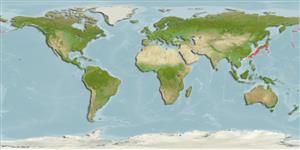Environment: milieu / climate zone / depth range / distribution range
Ekologi
laut batidemersal; kisaran kedalaman 792 - 1200 m (Ref. 28494). Deep-water
Northwest Pacific: central and southern Japan and Nintoku Seamount. Recently recorded from Taiwan (Ref. 54421).
Size / Weight / umur
Maturity: Lm ? range ? - ? cm
Max length : 63.5 cm TL jantan/; (Ref. 54421)
deskripsi pendek
Kunci identifiaksi (pengenalan) | Morfologi | Morfometrik
Head very wide and rather elongate. Bones of head soft and cavernous. Orbit small. Mouth terminal and oblique. Teeth minute, roughly equal, with arrow-shaped tip, set in broad band on premaxillary and in narrow band on dentary. No teeth on vomer or palatine. No barbel. Scales cycloid, small, and deciduous. Scales on mandibular ramus comparatively large, arranged in a single row (Ref. 54421).
Life cycle and mating behavior
Kematangan | Reproduksi, perkembang biakan | Pemijahan | telur-telur | Fecundity | Larva
Masuda, H., K. Amaoka, C. Araga, T. Uyeno and T. Yoshino, 1984. The fishes of the Japanese Archipelago. Vol. 1. Tokai University Press, Tokyo, Japan. 437 p. (text). (Ref. 559)
Status IUCN Red List (Ref. 130435: Version 2024-1)
ancaman kepada manusia
Harmless
penggunaan manusia
Alat, peralatan
laporan khas
muat turun XML
Sumber internet
Estimates based on models
Preferred temperature (Ref.
123201): 4 - 5, mean 4.6 °C (based on 14 cells).
Phylogenetic diversity index (Ref.
82804): PD
50 = 0.5001 [Uniqueness, from 0.5 = low to 2.0 = high].
Bayesian length-weight: a=0.00372 (0.00141 - 0.00976), b=3.11 (2.88 - 3.34), in cm total length, based on LWR estimates for this (Sub)family-body shape (Ref.
93245).
Trophic level (Ref.
69278): 3.2 ±0.3 se; based on size and trophs of closest relatives
Fishing Vulnerability (Ref.
59153): Moderate to high vulnerability (45 of 100).
